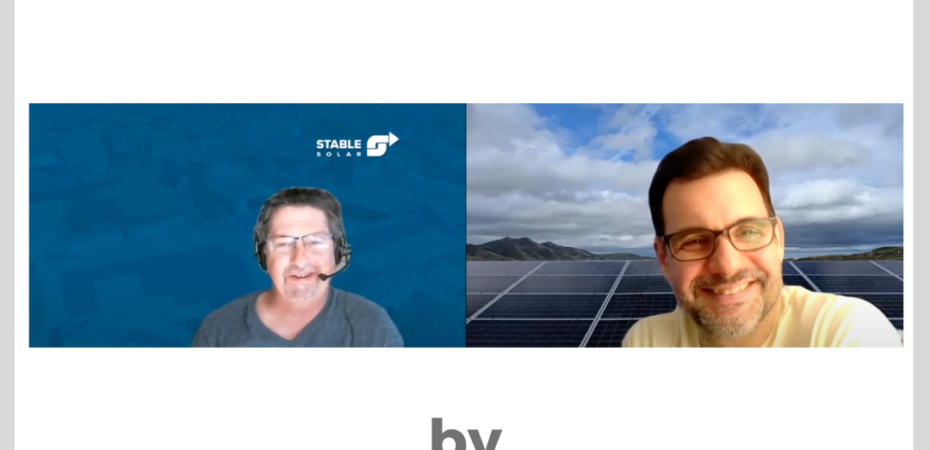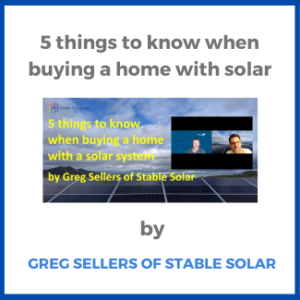Founder of solar maintenance and monitoring company Stable Solar Greg Sellers talks about what to keep in mind when buyers are looking to purchase a home that already has a solar system on it. He covers issues like the role of the installer, necessary paperwork and what they should learn about the system. Greg also touches on inverter ownership, monitoring, legal constraints and roof issues.
Transcription of the video:
Solar Academy: Hi, everyone, this is Kerim with Solar Academy. Again, we have Greg sSellers of Stable Solar. This week we’re going to talk about before you buy a home with solar, what are the things you’ve got to pay attention to. Greg, since you’re in the O&M business for solar homeowners helping them with their solar issues, this is something you encounter quite a bit.
Sellers: We see it all the time, Kerim. We moved about five years ago. We had solar on our old home, and I really missed not having it. We’re like the folks who don’t take care of their own stuff. But eventually, we got solar on our house. But when we sold it, I made sure that I told the new owners all about the solar installation. And of course, I was very involved, that was a very easy thing to do.
We get calls, though, all the time from people who don’t have any idea. They got the solar, they were told that it works. And they just take it at that, and they get their bill every month and it’s pretty low. Half the time, they don’t even know about true ups, which is a whole mystery that they find out about the hard way about six months after they buy it. And then a lot of times, though, they won’t find out there’s anything about the system that they need to worry about until it goes offline, and then they get a big bill. Or they just see a big difference. And so there’s a few things that we advise that folks keep in mind.
If you’re looking at a house and it has solar on it, and you’re thinking about buying it, first of all good for you, you should be doing that, it’s positive. But a couple of things to keep in mind: the easy first one is to find out who the installer was and how old the system is. And try to reach out to the installer and see how receptive they are, if they have servicing, find out any warranties still on it. What are those? How do they transfer?
The second thing is to keep in mind is to make sure that there’s monitoring on the system that you can actually track. And then you have to make sure that’s transferred to your name. We get a lot of folks where some of the big microinverter companies are transferring, but they’re charging it in some places. And there’s a variety of issues that you have to deal with in that transfer. And if it’s not done in the course of the sale of the house, then a lot of times you’re stuck trying to reach out to the old homeowner after they’ve moved. I did that too. With my old home when we sold it, I had to help the new buyer with a number of things.
Solar Academy: Yeah. To transfer the dashboard in my case I kind of remember maybe even involving the installer. Does the installer have to be involved in that transfer process? Or can it happen without? We’re talking about the major 3, 4, 5 brands of inverters: Enphase, SolarEdge, Fronius, SMA. Right?
Sellers: Yeah. And there’s a little bit different processes. Enphase recently changed their process. So it is both better and worse, there’s a little more cost involved. But they’ve tried to make it a little more seamless. And so has SolarEdge. But it’s something that has to be done because there are constraints, a lot of them are legal. They’re constrained in terms of sharing data, so you have to go through a process to legally request it and make sure you do it the right way. There’s a transfer form and things you have to go through.
The reason you want to get an installer involved if they’re available is that a good installer will not only make sure the original installation has monitoring but will oftentimes be tracking it themselves. If they don’t – and we’re finding one of the big things that we do at Stable Solar is track monitoring on behalf of our customers. So we have hundreds of customers who we track every month just make sure their systems are doing what they’re supposed to be doing. It doesn’t take away that power from the homeowner. In fact, we strongly encourage homeowners to reach out, but it’s something that you have to keep in mind and do diligently. Homeowners appreciate it. As a good installer we will reach out and say, hey, we noticed something different and give them some thoughts on what to do.
The last thing to do is inspect it just as you do with the rest of the home. A good good friend of ours and a colleague of mine is selling their home in Arizona. And he just went through a whole process with the inspection and they do a whole house inspection and there’s a few items to fix. I’m always amazed that they don’t do as good an inspection with solar as they do with the rest of the house. So either incorporate it the inspection process like a lot of companies out there like us do. An installer can go out and take photos of the system, upload those, it’s a very simple way to do that. And then we have different technicians who look at the system remotely from the photos and can tell pretty quickly if there’s any issues that that ought to be dealt with. So it’s a pretty straightforward process.
Those are a few things to keep in mind. The last one is just to gauge the performance, make sure it’s performing as expected. Also, make sure that you get all of the paperwork from the system. It’ll tell you what the components are, it’ll tell you what the warranties are, it’ll tell you when it was installed. All of that, because 5, 7, 8 years from now, when you have to call somebody to get it serviced they’re going to ask you things like, what kind of inverter do you have, when was it installed? What kind of what kind of panels do you have? How big are they? And you need to know all of that when you’re dealing with that. So those are a few things to keep in mind.
When you’re getting it installed, the only other thing I would think of, and of course we keep dealing with issues, is as part of the inspection you should get the roof inspected and learn how old the roof is. And I generally advise that if the roof has a 25 year warranty, if it’s over 15, close to 20 years old it’s something you need to be aware of because removing and replacing the solar installation is not an inexpensive prospect. So you just need to keep that in mind.
But the main thing is just to make sure that you have all the information you need about what the system is doing, what is expected and that you can track performance. If you do those things, you’re going to have a great system for many years to come.
Solar Academy: Thank you for this information.
Sellers: Great, sure.


